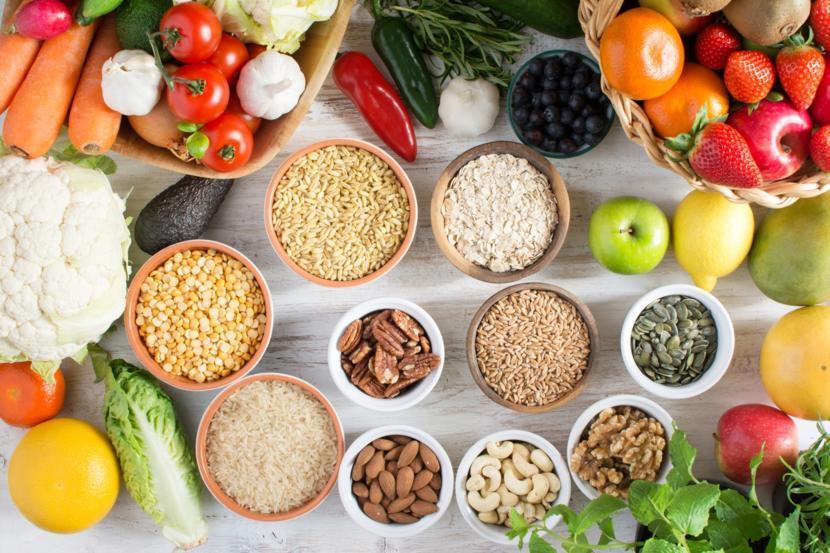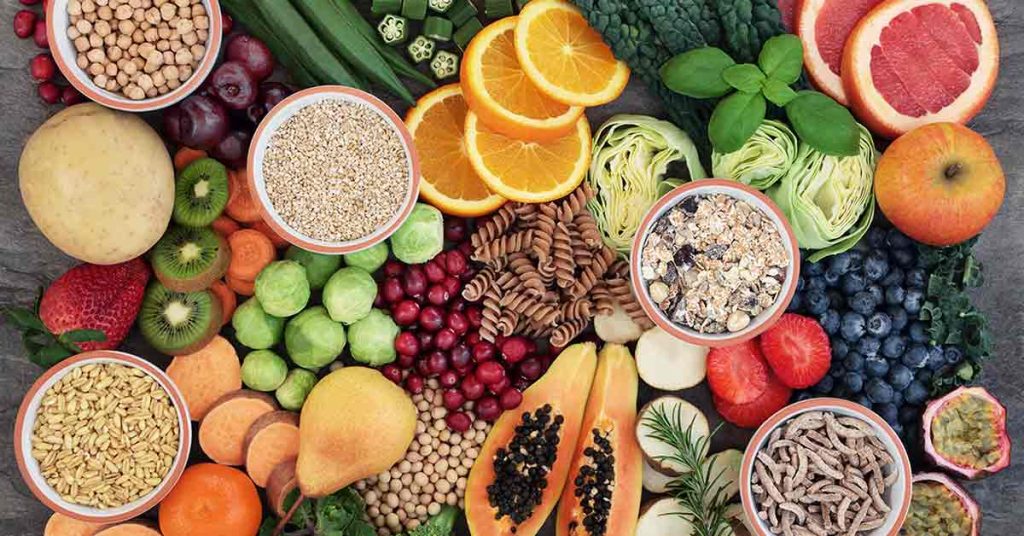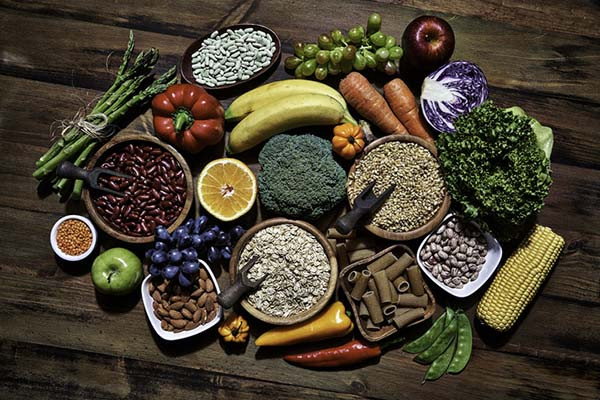Foods high in fiber are essential components of a healthy diet, yet many people struggle to incorporate them effectively. Dietary fiber, the indigestible part of plant-based foods, plays a crucial role in maintaining optimal health. But what are fiber foods exactly? They’re plant-based edibles rich in complex carbohydrates that our bodies can’t break down completely.
The importance of fiber in our daily nutrition cannot be overstated. It aids digestion, promotes regular bowel movements, and helps maintain a healthy gut microbiome. Moreover, a diet rich in fiber has been linked to numerous health benefits, including weight management, improved heart health, and better blood sugar control.
Understanding what are high fiber foods and how to include them in your meals is key to reaping these benefits. From fruits and vegetables to whole grains and legumes, nature provides an abundance of options to boost your fiber intake and enhance your overall well-being.
Types of dietary fiber
When exploring what are high fiber foods, it’s crucial to understand that dietary fiber comes in two main varieties: soluble and insoluble. Each type plays a unique role in maintaining our health and well-being.
Soluble fiber dissolves in water, forming a gel-like substance in the digestive tract. This type of fiber is found in foods high in fiber such as oats, barley, nuts, seeds, beans, lentils, and some fruits and vegetables. Soluble fiber:
- Slows digestion, promoting a feeling of fullness
- Helps lower cholesterol levels
- Regulates blood sugar levels
- Feeds beneficial gut bacteria
Insoluble fiber, on the other hand, doesn’t dissolve in water. It passes through the digestive system largely intact, adding bulk to stool and promoting regular bowel movements. Good sources of fiber rich in the insoluble type include:
- Vegetables high in fiber like cauliflower and green beans
Insoluble fiber aids in preventing constipation, reducing the risk of hemorrhoids, and may help in lowering the risk of colorectal cancer.
Both types of fiber are essential for a balanced diet. When considering what are high fiber foods, it’s beneficial to include a variety of sources to ensure you’re getting both soluble and insoluble fiber. This combination promotes optimal digestive health and overall well-being.
Health benefits of high-fiber diet
Incorporating foods high in fiber into your daily meals can lead to numerous health benefits that extend far beyond digestive regularity. Let’s explore the remarkable ways a fiber-rich diet can enhance your overall well-being.
Digestive Health:
Fiber acts as a natural cleanser for your digestive system. It adds bulk to stool, promoting regular bowel movements and preventing constipation. Good sources of fiber like legumes, whole grains, and vegetables help nourish beneficial gut bacteria, supporting a healthy microbiome. This can reduce the risk of digestive disorders such as irritable bowel syndrome and diverticulitis.
Weight Management:
Foods high in fiber play a crucial role in weight control. They tend to be more filling, helping you feel satisfied with fewer calories. Fiber-rich foods also slow down digestion, which can prevent overeating and promote a healthy weight. For instance, adding chia seeds or oats to your breakfast can keep you full longer, reducing the temptation to snack on high-calorie foods.
Blood Sugar Control:
Consuming foods high in fiber, especially soluble fiber, can help regulate blood sugar levels. Fiber slows the absorption of sugar, preventing rapid spikes in blood glucose. This is particularly beneficial for people with diabetes or those at risk of developing the condition. Incorporating beans, lentils, and vegetables high in fiber into your meals can contribute to better glycemic control.
Heart Health:
A diet rich in fiber can significantly improve heart health. Soluble fiber found in oats, barley, and fruits can help lower LDL (bad) cholesterol levels. Additionally, a high-fiber diet is associated with reduced blood pressure and inflammation, both of which are risk factors for heart disease. Regular consumption of good sources of fiber like whole grains and legumes may lower the risk of cardiovascular events.
Cancer Prevention:
While more research is needed, some studies suggest that a high-fiber diet may help reduce the risk of certain types of cancer, particularly colorectal cancer. The protective effect may be due to fiber’s ability to promote regular bowel movements, reducing the exposure of the intestinal lining to potential carcinogens. Foods high in fiber often contain antioxidants and other beneficial compounds that may contribute to cancer prevention.
Top 15 foods high in fiber
Incorporating foods high in fiber into your diet is essential for maintaining optimal health. Here’s a diverse list of fiber-rich options, including fruits, vegetables, grains, and legumes, along with their nutritional benefits and serving suggestions.
- Navy Beans
Fiber content: 19g per cup (cooked)
Navy beans are an excellent source of plant-based protein and iron. They’re also rich in folate and magnesium. Try adding them to soups, stews, or salads for a fiber boost.
- Raspberries
Fiber content: 8g per cup
These berries are packed with vitamin C and manganese. They’re also low in calories, making them perfect for weight management. Enjoy them fresh as a snack or add them to yogurt and oatmeal.
- Artichokes
Fiber content: 10g per medium artichoke
Artichokes are among the vegetables high in fiber and are rich in antioxidants. They’re also a good source of vitamin C and K. Steam them and serve with a dipping sauce or add them to pasta dishes.
- Chia Seeds
Fiber content: 10g per ounce
These tiny seeds are packed with omega-3 fatty acids and calcium. They absorb liquid and form a gel, making them great for puddings or as an egg substitute in baking.
- Avocado
Fiber content: 13g per avocado
Avocados are rich in heart-healthy monounsaturated fats and potassium. Spread them on toast, add to smoothies, or use as a base for creamy dressings.
- Lentils
Fiber content: 15g per cup (cooked)
Lentils are an excellent source of plant-based protein and iron. They’re versatile and can be used in soups, salads, or as a meat substitute in many dishes.
- Pears
Fiber content: 5.5g per medium pear
Pears are rich in vitamin C and copper. They’re delicious eaten fresh or can be poached for a elegant dessert.
- Bulgur
Fiber content: 8g per cup (cooked)
This whole grain is high in manganese and magnesium. It cooks quickly and is perfect for salads, pilafs, or as a substitute for rice.
- Broccoli
Fiber content: 5g per cup (cooked)
Broccoli is one of the vegetables high in fiber and is packed with vitamin C and K. It’s also a good source of folate. Steam it lightly and serve as a side dish or add to stir-fries.
- Split Peas
Fiber content: 16g per cup (cooked)
Split peas are rich in protein and various B vitamins. They’re perfect for hearty soups and can be used to make vegetarian patties.
- Acorn Squash
Fiber content: 9g per cup (cooked)
This winter squash is rich in vitamin A and potassium. Roast it with a drizzle of honey for a delicious side dish.
- Oats
Fiber content: 4g per cup (cooked)
Oats are rich in beta-glucan, a type of soluble fiber that helps lower cholesterol. They’re versatile and can be used for breakfast, in baking, or as a crunchy topping.
- Guava
Fiber content: 9g per cup
Guavas are exceptionally high in vitamin C and also contain lycopene. Enjoy them fresh or add to smoothies for a tropical twist.
- Brussels Sprouts
Fiber content: 4g per cup (cooked)
These mini cabbages are among the vegetables high in fiber and are rich in vitamin K and C. Roast them with olive oil and garlic for a delicious side dish.
- Quinoa
Fiber content: 5g per cup (cooked)
Quinoa is a complete protein and is rich in iron and magnesium. Use it as a base for grain bowls or as a substitute for rice in many dishes.
Incorporating these foods high in fiber into your daily diet can significantly boost your fiber intake, promoting better digestive health, aiding weight management, and potentially reducing the risk of various chronic diseases. Remember to increase your fiber intake gradually and drink plenty of water to avoid digestive discomfort.
Incorporating high-fiber foods into your diet
Understanding what are fiber foods and how to include them in your daily meals is crucial for reaping the benefits of a high-fiber diet. Here are some practical tips and sample meal plans to help you boost your fiber intake.
Practical Tips for Increasing Fiber Intake:
- Start your day right: Choose whole grain cereals or oatmeal for breakfast, topped with berries or sliced banana for an extra fiber boost.
- Snack smart: Keep raw vegetables like carrot sticks or cherry tomatoes handy for a quick, fiber-rich snack.
- Embrace whole grains: Opt for whole wheat bread, pasta, and brown rice instead of their refined counterparts.
- Leave the skin on: When eating fruits and vegetables, keep the edible peels on to maximize fiber content.
- Sprinkle seeds: Add chia seeds or flaxseeds to yogurt, smoothies, or salads for a fiber boost.
- Legume love: Incorporate beans, lentils, and peas into soups, salads, and main dishes.
- Fiber-rich desserts: Choose fruits or nuts for dessert instead of sugary treats.
Sample Meal Plan:
Here’s a day’s worth of meals showcasing good sources of fiber:
- Breakfast: Oat bran flakes with milk and banana slices
- Snack: Carrot sticks with hummus
- Lunch: Jacket potato (with skin) topped with baked beans and grated cheese
- Dinner: Vegetable curry with lentils and brown rice
- Dessert: Apple slices drizzled with honey
This meal plan provides a variety of foods high in fiber throughout the day, making it easier to reach the recommended 25-30 grams of fiber daily.
Potential risks and considerations
While foods high in fiber offer numerous health benefits, it’s important to approach increasing your fiber intake with caution. Abruptly consuming large amounts of fiber can lead to unexpected digestive issues.
Gradual Increase:
When incorporating more foods high in fiber into your diet, it’s crucial to do so gradually. A sudden spike in fiber consumption can overwhelm your digestive system, potentially causing bloating, gas, and abdominal discomfort. Start by adding one extra serving of fiber-rich food per day and slowly increase over several weeks.
Hydration is Key:
As you boost your fiber intake, it’s essential to increase your water consumption simultaneously. Fiber absorbs water, and without adequate hydration, it can lead to constipation – the opposite of what you’re trying to achieve. Aim to drink at least 8 glasses of water daily when consuming foods high in fiber.
Possible Digestive Discomfort:
Even with a gradual increase, some people may experience temporary digestive discomfort when adding more fiber to their diet. Symptoms like bloating, gas, or changes in bowel movements are common but usually subside as your body adjusts. If discomfort persists, consult with a healthcare professional.
Individual Variations:
It’s worth noting that fiber tolerance can vary from person to person. Some individuals, particularly those with certain digestive conditions, may need to be more cautious with high-fiber foods. Always listen to your body and adjust your intake accordingly.
Fiber supplements vs. whole foods
When considering what are high fiber foods, it’s important to compare the benefits of whole foods to fiber supplements. While both can contribute to your daily fiber intake, they offer different advantages and drawbacks.
Whole Foods:
Pros:
- Provide a wide range of vitamins, minerals, and beneficial compounds
- Offer a variety of fiber types (soluble and insoluble)
- Support overall gut health and diverse microbiome
- Contribute to better heart health and reduced disease risk
Cons:
- May require more preparation and planning
- Can be challenging to consume enough for those with dietary restrictions
Fiber Supplements:
Pros:
- Convenient and easy to incorporate into daily routines
- Can help normalize bowel movements
- Useful for specific digestive issues
Cons:
- Lack the additional nutrients found in whole foods
- May cause digestive discomfort if introduced too quickly
- Don’t provide the same range of health benefits as fiber-rich foods
Supplements might be necessary when:
- Following restrictive diets (e.g., low FODMAP, keto)
- Experiencing temporary digestive issues
- Unable to meet fiber needs through diet alone due to health conditions
While supplements can be beneficial in certain situations, they shouldn’t replace foods high in fiber in your diet. Whole foods offer a more comprehensive approach to nutrition and long-term health benefits that supplements alone cannot match.
High-fiber recipes
Incorporating foods high in fiber into your daily meals can be both delicious and nutritious. Here are three simple, fiber-rich recipes that showcase vegetables high in fiber and other good sources of fiber.
- Lentil and Vegetable SoupIngredients:
- 2 cups mixed vegetables high in fiber (carrots, celery, onions)
Instructions:
- Sauté vegetables in olive oil for 5 minutes.
- Add garlic and cumin, cook for 1 minute.
- Add lentils and broth, simmer for 20 minutes.
- Season and serve.
Nutritional info (per serving): Fiber: 8g, Calories: 200, Protein: 12g
- Quinoa and Black Bean SaladIngredients:
- 1 can black beans, rinsed
- 1 cup cherry tomatoes, halved
- 1/4 cup red onion, finely chopped
Instructions:
- Mix quinoa, beans, tomatoes, avocado, and onion in a bowl.
- Whisk lime juice and olive oil for dressing.
- Toss salad with dressing, season, and serve.
Nutritional info (per serving): Fiber: 12g, Calories: 300, Protein: 10g
- Berry and Chia Seed PuddingIngredients:
Instructions:
- Mix chia seeds, almond milk, and honey in a jar.
- Refrigerate overnight.
- Top with berries and nuts before serving.
Nutritional info (per serving): Fiber: 15g, Calories: 250, Protein: 8g
These recipes demonstrate how easy it is to incorporate good sources of fiber into your meals. They combine various foods high in fiber to create balanced, nutritious dishes that support digestive health and overall well-being.
Your path to optimal health and wellness
Incorporating foods high in fiber into your daily diet is a powerful step towards better health. From improving digestive function to supporting heart health and weight management, fiber plays a crucial role in our overall well-being. By understanding what are high fiber foods and how to include them in your meals, you can easily boost your fiber intake. Remember, a diverse range of fruits, vegetables, whole grains, and legumes offers the best mix of soluble and insoluble fiber. Start small, increase gradually, and stay hydrated. Your body will thank you for making foods high in fiber a regular part of your nutritional routine. Embrace these fiber-rich options and enjoy the journey to a healthier you.
|
|










